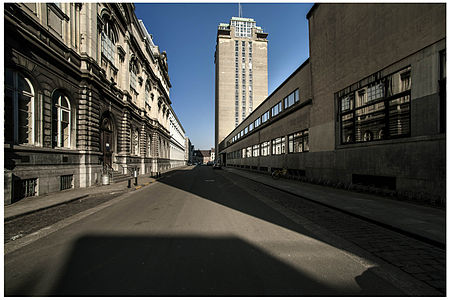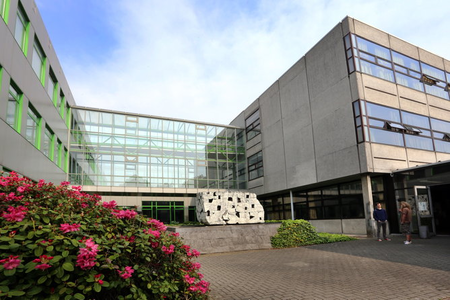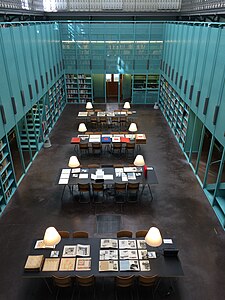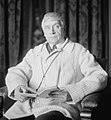This is an old revision of this page, as edited by Foosland (talk | contribs) at 15:36, 14 June 2022 (Updated latest results from Horizon2020 report on EU funding recipients). The present address (URL) is a permanent link to this revision, which may differ significantly from the current revision.
Revision as of 15:36, 14 June 2022 by Foosland (talk | contribs) (Updated latest results from Horizon2020 report on EU funding recipients)(diff) ← Previous revision | Latest revision (diff) | Newer revision → (diff) Dutch-speaking university in Belgium
| Universiteit Gent | |
 Seal of Ghent University Seal of Ghent University | |
| Latin: Academia Gandavensis | |
| Former names | State University of Ghent |
|---|---|
| Motto | Sapere Aude (Latin) |
| Motto in English | Dare to Think/Durf Denken |
| Type | Public |
| Established | 1817; 208 years ago (1817) |
| Rector | Rik Van de Walle |
| Administrative staff | 9,000 |
| Students | +44,000 |
| Location | |
| Campus | University town |
| Colours | UGent corporate blue & white |
| Affiliations | CESAER EUA The Guild SGroup ENLIGHT 3I University Network 3C Partnership |
| Website | www |
| [REDACTED] | |
Ghent University (Template:Lang-nl, abbreviated as UGent) is a public research university located in Ghent, Belgium.
Established before the state of Belgium itself, the university was founded by the Dutch King William I in 1817, when the region was incorporated into the United Kingdom of the Netherlands after the fall of First French Empire. In that same year, he founded two other universities for the southern provinces as well, alongside Ghent University: University of Liège and State University of Leuven.
After the Belgian revolution of 1830, the newly formed Belgian state began to administer Ghent University. In 1930, UGent became the first Dutch-speaking university in Belgium. Previously, French (and, even earlier, Latin) had been the standard academic language in what was Université de Gand. In 1991, it was granted major autonomy and changed its name accordingly from State University of Ghent (Template:Lang-nl, abbreviated as RUG) to its current designation.
Located in Flanders, Ghent is one of the largest Belgian universities, consisting of 44,000 students and 9,000 staff members. The university also supports the Ghent University Library (including the famous Boekentoren) and the Ghent University Hospital, which is one of the biggest hospitals in Belgium.
An avowedly research-driven and socially minded university, UGent consistently rates among the top 100 universities in the world. It is one of the greatest beneficiaries of funding from the Flemish research council. It was also among the Top 30 recipients of major research grants awarded by the European Research Council under the funding framework Horizon 2020 (2014–2020).
History

Foundation, in the 19th century
The university in Ghent was opened on 9 October 1817, with JC van Rotterdam serving as the first rector. The university was founded by King William I as part of a policy to stem the intellectual and academic lag in the southern part of the United Kingdom of the Netherlands, later to become Belgium. The original four faculties consisted of Humanities (Letters), Law, Medicine, and Science, with the language of instruction being Latin. In the first year, it had 190 students and 16 professors. In 1882, Sidonie Verhelst became the first female student at the university.

After peaking at a student population of 414, the number of students declined quickly following the Belgian Revolution. At this time, the faculties of humanities and science were broken from the university, but they were restored five years later, in 1835. At this time, French also became the language of instruction, taking the place of Latin. However, in 1903 the Flemish politician Lodewijk De Raet would lead a successful campaign to begin instruction in Dutch, and the first courses were begun in 1906.
Ghent University played a role in the foundation of modern organic chemistry. Friedrich August Kekulé (7 September 1829 – 13 July 1896) unraveled the structure of benzene at Ghent and Adolf von Baeyer (Johann Friedrich Wilhelm Adolf von Baeyer), a student of August Kekulé, made contributions to organic chemistry.

Developments since the 20th century
During World War I, the occupying German administration conducted Flamenpolitik and turned Ghent University into the first Dutch-speaking university in Belgium. A Flemish Institute (Vlaemsche Hoogeschool), commonly known as Von Bissing University, was founded in 1916 but was disestablished after the war and French language was fully reinstated. In 1923, Cabinet Minister Pierre Nolf put forward a motion to definitively establish the university as a Dutch-speaking university, and this was realized in 1930. August Vermeylen served as the first rector of a Dutch-language university in Belgium.

In the Second World War, the German administration of the university attempted to create a German orientation, removing faculty members and installing loyal activists.
After the war, the university became a much larger institution, following government policy of democratizing higher education in Flanders during the 1950s and 1960s. By 1953, there were more than 3,000 students, and by 1969 more than 11,500. The number of faculties increased to eleven, starting with Applied Sciences in 1957. It was followed by Economics and Veterinary Medicine in 1968, Psychology and Pedagogy, as well as Bioengineering, in 1969, and Pharmaceutical Sciences. The faculty of Politics and Social Sciences is the most recent addition, in 1992. In the 1960s to 1980s, there were several student demonstrations at Ghent University, notably around the Blandijn site, which houses the Faculty of Arts & Philosophy. The severest demonstrations took place in 1969 in the wake of May 1968.
In 1991, the university officially changed its name from Rijksuniversiteit Gent (RUG) to Universiteit Gent (UGent), following an increased grant of autonomy by the government of the Flemish Community.

1 Ufo – university forum / 2 Economics and Business Administration / 3 De Brug - university cafeteria / 4 Boekentoren – university library / 5 Ledeganck – Exact Sciences and Botanical Garden / 6 Blandijn – Humanities / 7 Plateau & Rozier – Applied Sciences / 8 Observatory Armand Pien / 9 Therminal – Student Society Building / 10 UZ – Medicine & Health Sciences / 11 Home Boudewijn
Academic profile

Organisation and structure
Ghent University consists of eleven faculties with over 130 individual departments. In addition, the university maintains the Zwijnaarde science park and Greenbridge science park.
List of faculties
- Faculty of Arts and Philosophy
- Faculty of Bio-science Engineering
- Faculty of Law
- Faculty of Sciences
- Faculty of Medicine and Health Sciences
- Faculty of Engineering and Architecture
- Faculty of Economics and Business Administration
- Faculty of Veterinary Medicine
- Faculty of Psychology and Educational Sciences
- Faculty of Pharmaceutical Sciences
- Faculty of Political and Social Sciences
Library
Standing on the Blandijnberg, the Boekentoren houses the Ghent University Library, which contains nearly 3 million volumes. The university library has joined the Google Books Library Project. Among other notable collections, it preserves Papyrus 30, an early manuscript of the Greek New Testament.
The university is also a partner in the development of De Krook, the new public library and media center in the center of Ghent, opened in 2017.

Reputation & rankings
| University rankings | |
|---|---|
| Global – Overall | |
| ARWU World | 66 (2020) |
| CWUR World | 118 (2020-21) |
| CWTS World | 75 (2020) |
| QS World | =135 (2021) |
| Reuters World | 98 (2019) |
| THE World | =96 (2022) |
| USNWR Global | 85 (2021) |
| National – Overall | |
| ARWU National | 1 (2020) |
| CWTS National | 2 (2020) |
| CWUR National | 2 (2020-21) |
| QS National | 2 (2021) |
| THE National | 2 (2021) |
| USNWR National | 2 (2021) |
Ghent University consistently ranks among the top 100 universities in the world and, alongside the Catholic University of Leuven, the best in Belgium. In 2017, it was ranked, globally, 69th by the Academic Ranking of World Universities (or Shanghai ranking) and 125th by QS World University Rankings. For 2021, Ghent University has been ranked, worldwide, 85th by U.S. News & World Report and 96th by Times Higher Education.
International relations


The university maintains many partnerships within Belgium, across Europe, and throughout the world.
Inside Belgium, Ghent University supports the Belgian Co-ordinated Collections of Micro-organisms and the Vlaams Instituut voor Biotechnologie.
Within Europe, it is a member of the Santander Network, the Enlight (previously the U4) Network, and the 3i University Network. It also participates in the Conference of European Schools for Advanced Engineering Education and Research. In addition, the university cooperates with numerous universities for the Erasmus and Erasmus Mundus programs; within the framework of the latter, it heads the International Master of Science in Rural Development and the International Master of Science in Soils and Global Change (IMSOGLO).
Beyond Europe, Ghent University conducts exchange programs on all six continents. Frameworks include its campus in South Korea and its 3C Partnership.
Associated contributions and innovations
Ghent University has been instrumental in the development of COinS and Unipept.
Gallery
-
Rommelaere Instituut
-
Law School
-
Rectorate
-
Botanical garden
-
 The Boekentoren, designed by Henry van de Velde, is one of the most famous university buildings
The Boekentoren, designed by Henry van de Velde, is one of the most famous university buildings
-
The Technicum, or Faculty of Engineering
-
 Aula Academica
Aula Academica
-
Faculty of Bioengineering
-
The Blandijn houses the Faculty of Letters and Philosophy
-
 UGent Campus in Kortrijk
UGent Campus in Kortrijk
-
Faculty of Psychology
-
-
 Library of the department of Architecture and Urbanism
Library of the department of Architecture and Urbanism
-
 Boekentoren
Boekentoren
-
 UGent Boekentoren
UGent Boekentoren
-
 Library of the Humanities Faculty
Library of the Humanities Faculty
-
Museum of Zoology
-
Institute for Anatomy
-
 Rectorate
Rectorate
-

-

People
-
 Johan Rudolf Thorbecke, statesman
Johan Rudolf Thorbecke, statesman
-
 Henri Pirenne, historian
Henri Pirenne, historian
-
 George de Hevesy, Nobel Prize winner in Chemistry
George de Hevesy, Nobel Prize winner in Chemistry
-
 Maurice Maeterlinck, Nobel Prize winner in Literature
Maurice Maeterlinck, Nobel Prize winner in Literature
-
 Corneel Heymans, Nobel Prize winner in Medicine
Corneel Heymans, Nobel Prize winner in Medicine
-
 Marguerite Legot, first female government minister in Belgium
Marguerite Legot, first female government minister in Belgium
-
 Yaakov Dori, president of the Technion, Haifa
Yaakov Dori, president of the Technion, Haifa
-
 Suzanne Lilar, feminist writer
Suzanne Lilar, feminist writer
-
 Jozef Schell (right), molecular biologist
Jozef Schell (right), molecular biologist
-
 Marc van Montagu, molecular biologist
Marc van Montagu, molecular biologist
-
 Robert Cailliau, co-inventor of the World Wide Web
Robert Cailliau, co-inventor of the World Wide Web
-
 Guy Verhofstadt, politician
Guy Verhofstadt, politician
-
 Gustave Rolin-Jaequemyns, jurist and diplomat
Gustave Rolin-Jaequemyns, jurist and diplomat
-
 Hélène Mallebrancke (1902-1940) Civil engineer and Belgian Resistance member in Second World War
Hélène Mallebrancke (1902-1940) Civil engineer and Belgian Resistance member in Second World War
Notable alumni
- Joseph Antoine Ferdinand Plateau (1801-1883), physicist, mathematician
- Leo Apostel (1925–1995), philosopher
- Leo Baekeland (1863–1944), chemist, inventor of Bakelite
- Wim Blockmans (born 1945), historian
- Thierry Bogaert, founder of DevGen
- Luc Bossyns, civil engineer
- Marc Bossuyt (born 1944), judge, professor
- Dries Buytaert (born 1978), computer scientist, founder of the Drupal CMS
- Robert Cailliau (born 1947), co-inventor of the World Wide Web
- Luc Coene, economy, governor of the National Bank of Belgium (NBB)
- Marc Coucke (born 1965), co-founder of Omega Pharma
- Martin De Prycker (born 1955), engineer
- Bertha De Vriese (1877–1958), first woman to enroll and graduate as a physician
- Franz Cumont (1868–1947), historian
- Jean Daskalidès [nl] (1922–1992), gynecologist, best known as chocolate maker of the brands Leonidas and Daskalidès.
- Bert De Graeve, law, businessman
- Michel de Kemmeter, author and researcher in human sustainable development
- Rudy Dekeyser, molecular biologist, assistant director of the VIB
- Arnoud De Meyer (presently) director of Judge Business School of the University of Cambridge
- Wim De Waele, economy and computer science, director of the IBBT
- Catherine de Zegher (born 1955), international curator, art critic, and art historian
- Martin Dobelle, veteran orthopedic surgeon
- Yaakov Dori, first chief of staff of the Israeli Defense Forces, president of the Technion – Israel Institute of Technology
- Paul Fredericq, historian
- Walter Fiers (born 1931), molecular biologist
- Leopold Flam (1912–1995), historian, philosopher
- Dirk Frimout (born 1941), physicist, astronaut
- Derrick Gosselin (born 1956), engineer, economist, business manager
- Joseph Guislain (1797–1860), physiologist and psychiatrist
- Jacques-Joseph Haus (1796–1881), jurist
- Lucienne Herman-Michielsens (1926–1995), law, politician
- Philippe Herreweghe (born 1947), doctor, psychiatrist, orchestra conductor
- Corneille Heymans (1892–1968), physiologist (Nobel prize winner)
- Jan Hoet, (1936–2014), art historian, museum director, founding director of the SMAK
- Mark Janse (born 1959), classicist and linguist
- Friedrich August Kekulé von Stradonitz (1829–1896), chemist
- Jaap Kruithof, philosopher
- Tom Lanoye (born 1958), philologist, writer
- François Laurent (1810–1887), jurist
- Marguerite Legot (1913–1977), jurist, first Belgian woman to serve as a government minister
- Yves Leterme (born 1960), prime minister of Belgium
- Emma Leclercq, cell biologist
- Herman Liebaers (born 1919), writer, former Marschal of the Royal Household.
- Suzanne Lilar (born Suzanne Verbist) (1901–1992), philosopher, jurist, essayist, novelist
- Julius Mac Leod (1857–1919), botanist
- Maurice Maeterlinck (1862–1949), jurist, writer (Nobel prize winner)
- Hélène Mallebrancke, first female Belgian civil engineer to graduate from the University of Ghent, Resistance member in Second World War
- Paul Mansion, mathematician
- Rudi Mariën, pharmacy, chairman of Innogenetics
- Gerard Mortier (1943–2014), artistic director
- Roland Peelman, conductor and musical director
- Jean-Pierre Nuel (1847–1920), physiologist
- Peter Piot (born 1949), doctor, assistant secretary-general of the United Nations
- Henri Pirenne (1862–1935), historian
- Karel Poma (born 1920), chemist and politician
- Ockert Potgieter (1965-2021), missionary and film director
- Adolphe Quetelet (1796–1874), statistician
- Godfried-Willem Raes (born 1952), composer, performer and instrument maker
- Jacques Rogge (born 1942), doctor, president of the International Olympic Committee
- Gustave Rolin-Jaequemyns (1835–1902), jurist, diplomat and cofounder of the Institut de droit international
- Jozef Schell (1935–2003), molecular biologist
- Ferdinand Augustijn Snellaert (1809–1872), physician and writer
- Luc Van den Bossche (born 1947), law, politician
- Guido van Gheluwe (born 1926), jurist and founder of the Orde van den Prince
- Herman Vanderpoorten (1922–1984), politician
- Hugo Van Heuverswyn (born 1948) chemist, biotech pioneer and businessman
- Ann Van Gysel, zoology
- Dirk Van de Put, businessman, incoming CEO of Mondelez International
- Karel van de Woestijne (1878–1929), writer
- Henry van de Velde (1863–1957), architect
- Alexander Van Dijck, pioneer in rare diseases
- Prudens van Duyse (1804–1859), writer
- Paul van Geert (born 1950), psychologist
- Marc Van Montagu (born 1933), biotech pioneer
- Désiré van Monckhoven (1934–1882), physicist
- Jules Van Praet (1806–1887), statesman
- Willy van Ryckeghem (born 1935), economist
- Piet Vanthemsche, veterinary surgeon
- Daniel Varoujan (1884–1915), Armenian poet
- Guy Verhofstadt (born 1953), former prime minister of Belgium, liberal European politician
- Dirk Verhofstadt (born 1955), publisher
- Etienne Vermeersch (1934–2019), philosopher
- Katrien Vermeire (born 1979), artist
- André Vlerick (1919–1990), economy
- Emile Waxweiler (1867–1916), engineer and sociologist
- Marc Zabeau (born 1949), zoology
Notable faculty
- S.N. Balagangadhara (born 1952), comparative science of cultures
- George de Hevesy (1885–1966), Nobel Prize winner, Chemistry
- François Laurent (1810–1887), historian and jurisconsult
- Jan De Maeseneer (born 1952), medicine, family medicine
- Georges De Moor (born 1953), medicine, medical informatics
- Walter Fiers (1931-2019), molecular biologist
- Corneille Heymans (1892–1968), physiologist (Nobel prize winner)
- Joseph Plateau (1801–1883), physicist
- Xavier Saelens (born 1965), biotechnology
- Jeff Schell (1935–2003), biotech pioneer
- Erwin Schrödinger (1887–1961), physicist (Nobel Prize winner), visiting scholar
- Johan Rudolf Thorbecke (1798–1872), statesman
- Marc Van Montagu (born 1933), biotech pioneer
- August Vermeylen (1872–1945), author, art historian, statesman
- Adolf von Baeyer (1835–1917), chemist (Nobel prize winner), visiting scholar
- August Kekulé (1829–1896), chemist
Rectors
- 1817–1818: Jean Charles Van Rotterdam
- 1818–1819: Franz-Peter Cassel [nl]
- 1819–1820: Jean Baptiste Hellebaut
- 1820–1821: Johannes Schrant [nl]
- 1821–1822: François Egide Verbeeck
- 1822–1823: Jean Guillaume Garnier
- 1823–1824: Pierre De Ryckere
- 1824–1825: Louis Vincent Raoul
- 1825–1826: Jacques Louis Kesteloot
- 1826–1827: Jean Charles Hauff
- 1827–1828: Jacques Joseph Haus
- 1828–1829: Pierre Lammens
- 1829–1830: Jozef Kluyskens [nl]
- 1830–1831: Jacques Van Breda
- 1831–1832: Leopold Auguste Warnkoenig
- 1832–1833: François Verbeeck
- 1833–1834: Jacques Joseph Haus
- 1834–1835: Jacques Louis Kesteloot
- 1835–1838: Jacques Joseph Haus
- 1838–1839: Philippe Auguste De Rote
- 1839–1840: Jozef Kluyskens [nl]
- 1840–1841: Jean Timmermans
- 1841–1842: Josephus Nelis
- 1842–1843: Georg Wilhelm Rassmann
- 1843–1844: Charles Van Coetsem
- 1844–1845: Marie-Charles Margerin
- 1845–1846: Jean-Baptiste Minne-Barth
- 1846–1847: Joseph Roulez
- 1847–1848: François Verbeeck
- 1848–1852: Eloi Manderlier
- 1852–1855: Hubert Lefebvre [Wikidata]
- 1855–1857: Constant Serrure [nl]
- 1857–1864: Joseph Roulez
- 1864–1867: Jacques Joseph Haus
- 1867–1870: Charles Andries [nl]
- 1870–1873: Joseph Jean Fuerison
- 1873–1879: Floribert Soupart [nl]
- 1879–1885: Albert Callier [nl]
- 1885–1887: Jean-Jacques Kickx
- 1887–1891: Gustave Wolters
- 1891–1894: Adhémar Motte
- 1894–1897: Charles Van Cauwenberghe
- 1897–1900: Polynice Van Wetter
- 1900–1903: Gustave Van der Mensbrugghe [nl]
- 1903–1906: Paul Thomas [nl]
- 1906–1909: Hector Leboucq
- 1909–1912: Victor De Brabandere [nl]
- 1912–1915: Henri Schoentjes
- 1916–1918: Pierre Hoffmann
- 1918–1919: Henri Schoentjes
- 1919–1921: Henri Pirenne
- 1921–1923: Eugène Eeman
- 1923–1924: Jean-François Heymans
- 1924–1927: Georges Van Den Bossche [Wikidata]
- 1927–1929: Camille De Bruyne
- 1929–1930: Jules Meuwissen [nl]
- 1930–1933: August Vermeylen
- 1933–1936: Albert Bessemans [nl]
- 1936–1938: Louis Fredericq [nl]
- 1938–1939: Jean Haesaert
- 1939–1941: René Goubau
- 1940–1944: Guillaume De Smet [nl]
- 1944–1947: Edgard Blancquaert [nl]
- 1947–1950: Norbert Goormaghtigh [nl]
- 1950–1953: Albert Kluyskens [nl]
- 1953–1957: Jan Gillis [nl]
- 1957–1961: Pieter Lambrechts
- 1961–1969: Jean-Jacques Bouckaert [nl]
- 1969–1973: Daniël Vandepitte [nl]
- 1973–1977: André Devreker [nl]
- 1977–1981: Julien Hoste [nl]
- 1981–1985: André Cottenie [nl]
- 1985–1993: Leon De Meyer [nl]
- 1993–2001: Jacques Willems [nl]
- 2001–2005: Andreas De Leenheer
- 2005–2013: Paul Van Cauwenberge
- 2013–2017: Anne De Paepe [nl]
- 2017–2021: Rik Van de Walle [nl]
Recipients of honorary doctorates
|
See also
- Associatie Universiteit Gent [nl]
- Belgian Co-ordinated Collections of Micro-organisms (BCCM)
- Flanders Interuniversity Institute of Biotechnology (VIB)
- Ghent Bio-Energy Valley
- Ghent University Hospital (UZ Gent)
- Ghent University Museum (GUM)
- Greenbridge science park
- Interuniversity Microelectronics Centre (IMEC)
- Open access in Belgium
- Science and technology in Flanders
- University Foundation
- Zwijnaarde science park
- List of modern universities in Europe (1801–1945)
- List of universities in Belgium
- List of Jesuit sites
Notes and references
- Basic principles: Corporate colours – website of the UGent
- "UGent Mission Statement".
- "Recent rankings overview".
- "ERC Report on Horizon 2020".
- "A Language Come Back", Time, 28 April 1923
- Danniau, Fien. "Haard van verzet" (in Dutch). UGent Memorie. Retrieved 10 January 2012.
- Vervaeke, Ann. "Faculteit Letteren en Wijsbegeerte – Faculteit Letteren en Wijsbegeerte".
- Vervaeke, Ann. "Faculteit Letteren en Wijsbegeerte – Faculteit Letteren en Wijsbegeerte".
- "Archived copy". Archived from the original on 6 April 2013. Retrieved 6 April 2013.
{{cite web}}: CS1 maint: archived copy as title (link) - "Faculty of Sciences — Ghent University".
- "Faculteit Geneeskunde en Gezondheidswetenschappen — Universiteit Gent".
- "Faculty of Engineering and Architecture — Ghent University".
- "Archived copy". Archived from the original on 3 April 2013. Retrieved 6 April 2013.
{{cite web}}: CS1 maint: archived copy as title (link) - "Faculty of Veterinary Medicine — Ghent University".
- "Faculteit Psychologie en Pedagoghische Wetenschappen (FPPW)".
- "Faculty of Pharmaceutical Sciences — Ghent University".
- "Faculty of Political and Social Sciences — Ghent University".
- ^ "Academic Ranking of World Universities 2020". ShanghaiRanking. Retrieved 8 January 2021.
- ^ "World University Rankings 2020-2021". Center for World University Rankings. Retrieved 8 January 2021.
- ^ "CWTS Leiden Ranking 2020 - P(top 10%)". CWTS Leiden Ranking. Retrieved 7 March 2021.
- ^ "QS World University Rankings 2021". QS Top Universities. Retrieved 8 January 2021.
- "Reuters World's Top 100 Innovative Universities 2019". Thomson Reuters. Retrieved 8 January 2021.
- "World University Rankings 2022 - Ghent University". Times Higher Education. Retrieved 3 September 2021.
- "Best Global Universities 2021 - Ghent University". U.S. News Education. Retrieved 8 January 2021.
- "World University Rankings 2021 - Ghent University". Times Higher Education. Retrieved 8 January 2021.
- "Best Global Universities in Belgium". U.S. News Education. Retrieved 8 January 2021.
- "Shanghai Ranking 2017 Results".
- "QS Top Universities Ranking 2014–2015". 16 July 2015.
- "Best Global Universities 2021".
- "The Times Higher Education World University Rankings". timeshighereducation.com. 3 September 2021.
- "Home". IMSOGLO. Retrieved 20 February 2019.
- "Bestemmingen — Studentenportaal — Universiteit Gent". ugent.be.
- "Daskalidès, Jean (1922–1992) | UGentMemorie". Ugentmemorie.be. 16 August 2010. Retrieved 15 October 2013.
External links
| Ghent University | ||
|---|---|---|
| Repositories and notable holdings |  | |
| Science parks | ||
| Associated developments and innovations | ||
| Partner institutions and major collaborations | ||
| Sponsored publications | ||
| Sports and student life | ||
| Universities in Belgium | |
|---|---|
| Dutch-speaking |
|
| French-speaking |
|
| Others | |
| Postgraduate | |
| Military | |
51°02′48″N 3°43′41″E / 51.046582°N 3.727918°E / 51.046582; 3.727918
Categories: